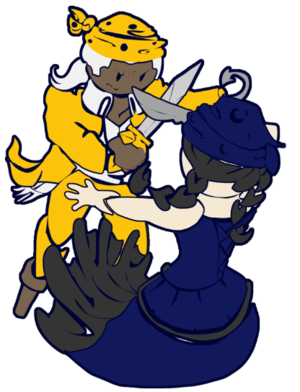Obsidian Swordfighting League
Before automated tournaments existed in-game, groups of players would create their own unique competitions, some of which - like Midnight Ocean’s Black Death Tournaments - even went on to become annual events. During the early 2000s (2003 - 2006), a series of OM-supported swordfighting events called The Olympic Champions League (OCL) tournaments were run by Apollo.
Inspired by the past, and in attempt to bring back the missing drama and desire that tournaments bring as a whole, a group of Obsidian pirates took a page from their predecessors in May of 2018 and created an event of their own. Incorporating what they felt were the best aspects of both the Black Death and OCL tournaments, the creation of the first, of what was hoped would be many, annual tournaments called the Obsidian Swordfighters League (or OSL Tournament) took place. What was most notable about this tournament series was that it was one of the first series which featured 'splitscreen' videos where spectators can view gameplay from two players' screens at the same time. From season 3 onwards, the tournament was renamed as the Oceanic Swordfighting League.
On September 2023, to reduce confusion, Oceanic Swordfighting League was once again rebranded. Whilst having origins from the Obsidian Swordfighting League, the tournament series is no longer based on Obsidian ocean. Furthermore, from OSL Season 3, the series had a shift in direction to provide the highly popularised livestreamed commentary format via Twitch. The previous OSL Season 3 and OSL Season 4 were rebranded to OSL 1 and OSL 2. The upcoming event OSL 3 coming in 2023 is referred to as OSL 3, rather than OSL Season 5. Please see below for further details.
Contents
Rules
The rules of the OSL prior to the 2018 revival were as follows:
- To qualify for the League, each participant had to have at least Solid or above experience in the swordfighting puzzle and either have received an invite or had to win 3 out of 5 back-to-back matches against the designated Blademaster for that year (receiving a specifically inscribed trinket as proof of an earned seat in the league).
- Once a player received their invite, or earned their seat, each pirate was then allotted two weeks to challenge every other League member (see "Tournament links" below for the complete member list) to a "Best Of 5" set of sword fights. 1 point was awarded for each match won, and the winner of the entire set itself was awarded an additional 1 point.
- A two week time frame was allotted to all League members for the completion of all of their sets. Anyone found to have not properly made themselves available during that time was considered to have forfeit the entire set, and the opponent was awarded three points for the forfeit.
- All entrants choosing to use a falchion were required to use either a green/green reversed, or a red/yellow non-reversed. This was to prevent gamesmanship oft-used where pirates would swap swords after one match with their opponent. Falchions were the only swords that had designated colors and were not allowed to be swapped; all other swords were unregulated. Pre-made falchions with these specific color patterns were also offered on loan by any TMS senior officer who was asked, in the case that a pirate was unable to access one him/herself.
- All members were also required to record their matches against their league opponent, and upload those recordings to a specified Google Drive. Failing to provide those recordings constituted a forfeit for the League member.
- Once each member fought every other pirate in the League, the members with the top ten highest points totals then advanced to a seeded tournament format.
Previous Winners for Obsidian Swordfighting League
- Season 1: Corteez (champion), Cremate (1st runner up)
- Season 2: Anemoi (champion), Pinkhas (1st runner up)
Previous Winners for Oceanic Swordfighting League
- OSL 1 (Previously known as OSL season 3): Johnydepp (champion), Intuitive (1st runner up)
- OSL 2 (Previously known as OSL season 4): Johnydepp (champion), Herse (1st runner up)
- OSL 3: Agbenq (champion), Necrozma (1st runner up)
